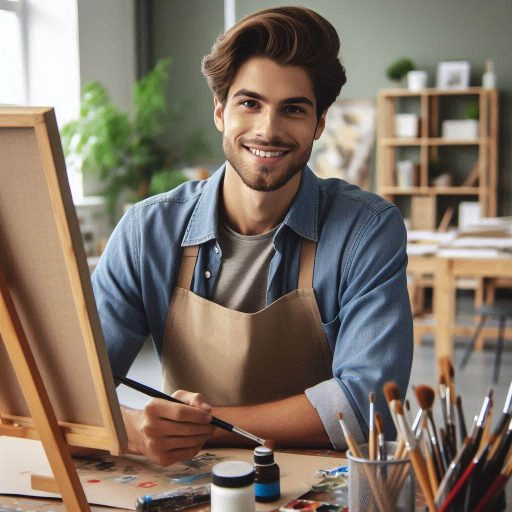Introduction
Art instructors play a key role in shaping creativity and artistic skills.
Meeting the educational requirements for this profession is essential.
Art education provides instructors with the knowledge and skills needed to teach various techniques and mediums effectively.
Educational qualifications for art instructors serve as a foundation for career success.
A formal education in art, such as a bachelor’s or master’s degree, provides the technical expertise required to instruct students.
It also helps instructors build credibility, making them more attractive to potential employers.
In addition to teaching art techniques, an educational background enables instructors to understand the history and theory behind art.
This knowledge allows them to enrich their students’ learning experience by providing context and deeper insight into various artistic practices.
Having proper educational qualifications can greatly impact career opportunities for art instructors.
Instructors with advanced degrees may qualify for higher-level positions, such as teaching at the college level or leading specialized workshops.
These roles often come with better compensation and increased opportunities for professional growth.
Educational qualifications also enhance an art instructor’s ability to stay competitive in the field.
With more art programs requiring formal education, those who lack the necessary credentials may find it difficult to secure positions.
A solid educational background provides art instructors with the skills and credentials needed to remain relevant and competitive in a rapidly evolving field.
In fact, educational requirements for art instructors are crucial for both professional credibility and career advancement.
By obtaining the proper education, art instructors can enhance their teaching abilities, expand career opportunities, and make a meaningful impact on their students.
Bachelor’s Degree in Fine Arts or a related field
The importance of having a foundational education in art
A bachelor’s degree in fine arts or a related field is crucial for art instructors.
Foundational education in art helps build a strong understanding of core art principles.
It equips instructors with theoretical knowledge and practical skills needed to teach art effectively.
Specific courses and skills that are essential for art instructors to possess
Specific courses in drawing, painting, sculpture, and digital media provide essential skills for teaching diverse art forms.
Transform Your Career Today
Unlock a personalized career strategy that drives real results. Get tailored advice and a roadmap designed just for you.
Start NowThese courses also encourage creative thinking, which is vital for art instruction.
Instructors gain proficiency in different artistic techniques, which they can pass on to students.
Art history is another key subject for instructors.
Knowledge of historical art movements helps instructors explain the evolution of artistic styles.
Understanding the cultural and social contexts behind these movements allows instructors to foster a deeper appreciation for art.
Additionally, courses in art education teach aspiring instructors how to develop lesson plans and engage students.
Art educators must know how to structure courses that cater to different learning styles.
This knowledge ensures that they can create inclusive and effective learning environments.
Moreover, skills in communication are essential for art instructors.
Effective communication helps instructors explain complex artistic concepts clearly.
Instructors also need to provide constructive feedback that encourages student growth.
Finally, technology plays a vital role in modern art instruction.
Courses on digital tools and software like Adobe Photoshop or Illustrator are essential.
Mastery of these tools allows instructors to teach digital art techniques, meeting the demands of contemporary art education.
In fact, a bachelor’s degree in fine arts provides the foundational skills necessary for becoming an effective art instructor.
Courses in traditional and digital art, art history, and education prepare instructors for success in the classroom.
Read: Costume Design for Theater vs. Film
Master’s Degree in Art Education or Art History
How a higher level degree can enhance teaching abilities and subject knowledge
A master’s degree in art education or art history significantly enhances an instructor’s teaching abilities and subject knowledge.
By deepening their understanding of art theory and practice, instructors can provide more insightful lessons.
This advanced education allows them to connect complex art concepts with real-world applications, fostering a richer learning experience for students.
Transform Your Career Today
Unlock a personalized career strategy that drives real results. Get tailored advice and a roadmap designed just for you.
Start NowA higher level degree also helps instructors stay current with emerging trends and methodologies in art education.
The benefits of specializing in a particular area of art for instructional purposes
Specializing in a particular area of art enables instructors to focus their expertise, which benefits both their teaching and their students’ learning.
Specialization helps them tailor their lessons to specific artistic movements, techniques, or media.
This focused approach allows students to gain in-depth knowledge in areas like sculpture, painting, or digital art.
Additionally, students learn not only the technical aspects but also the historical and cultural significance of the art form.
Master’s programs often include opportunities for instructors to conduct research and develop innovative teaching methods.
These methods can be applied in the classroom, offering students more interactive and engaging ways to learn.
By specializing, art instructors also position themselves as experts in their field, making them more valuable in the job market.
Instructors with a master’s degree can mentor students more effectively, guiding them through advanced projects and portfolios.
This advanced support prepares students for further academic pursuits or professional careers in art.
In turn, the instructor’s own professional growth is accelerated, opening doors to higher-level teaching positions and leadership roles in education.
In essence, earning a master’s degree in art education or art history enhances teaching abilities, expands subject knowledge, and benefits both students and instructors by offering specialized, focused instruction.
Read: Budgeting for a Costume Design Project
Teaching Certification or Licensure
The requirements for obtaining a teaching certification in art education
To become a certified art instructor, candidates must meet specific educational requirements.
Most states require a bachelor’s degree in art education or a related field.
The degree program typically includes coursework in both art techniques and educational theory.
In addition, candidates often need to complete a student teaching internship to gain practical classroom experience.
After completing these steps, aspiring art instructors must pass state-specific exams to demonstrate their knowledge and teaching abilities.
The importance of staying updated on educational standards and curriculum
Staying updated on educational standards and curriculum is crucial for art instructors.
Curriculum standards often evolve to reflect changes in both education and the art world.
Transform Your Career Today
Unlock a personalized career strategy that drives real results. Get tailored advice and a roadmap designed just for you.
Start NowTeachers must stay informed to ensure their lessons meet current expectations and align with state guidelines.
Continuing education courses and professional development opportunities provide essential updates and training.
Renewing teaching certifications also requires ongoing learning.
Many states mandate that instructors complete a certain number of professional development hours to maintain their certification.
These courses allow teachers to stay current with new teaching methods, technologies, and trends in art education.
Adapting to changing standards benefits both teachers and students.
It helps teachers refine their teaching techniques and provides students with a modern, relevant education.
Incorporating updated methods into lessons can also make learning more engaging and effective for students.
Overall, earning and maintaining teaching certification ensures that art instructors are qualified and knowledgeable.
By staying current with educational standards, they can provide high-quality instruction that prepares students for success in the art world and beyond.
Read: Pathway to Becoming a Successful Art Instructor

Continuing Education and Professional Development
The importance of attending workshops, conferences, and seminars
Ongoing education is vital for art instructors to stay updated with new teaching methods and techniques.
Attending workshops, conferences, and seminars provides valuable opportunities to expand one’s skillset.
These events introduce fresh ideas and perspectives that can inspire more effective classroom practices.
By participating in such events, art instructors can learn innovative approaches to engage students and improve their own artistic abilities.
Workshops and conferences also expose instructors to current trends in art education.
Staying informed helps instructors keep their curriculum relevant and exciting for their students.
Engaging with professional development opportunities ensures that art instructors maintain their teaching certification and credentials, making them more marketable in the field.
The benefits of networking and collaborating with other art educators
Another key benefit of attending these events is the networking opportunities they provide.
Collaborating with other art educators allows for the sharing of ideas and resources.
Transform Your Career Today
Unlock a personalized career strategy that drives real results. Get tailored advice and a roadmap designed just for you.
Start NowBuilding a professional network can help instructors exchange teaching strategies and create partnerships for joint projects.
These relationships can lead to collaborative exhibitions, workshops, and student showcases, benefiting both instructors and their students.
Networking also provides access to potential mentors who can offer guidance and support.
Learning from experienced educators fosters growth and can lead to new career opportunities.
Collaborative efforts with other educators broaden one’s perspective and enhance teaching effectiveness.
In essence, art instructors must embrace continuing education and professional development.
By attending workshops, conferences, and seminars, they enhance their teaching abilities and expand their networks.
These activities not only keep instructors updated but also foster meaningful collaboration, ensuring a successful and fulfilling career in art education.
Read: How to Get Costume Design Internships
Portfolio and Experience
The significance of having a strong portfolio of artwork and teaching samples
A strong portfolio is crucial for art instructors.
It showcases your artistic skills and teaching capabilities.
Include diverse artwork to demonstrate versatility.
Add teaching samples to highlight your pedagogical approach.
A well-organized portfolio reflects your commitment and professionalism.
It helps potential employers or clients gauge your expertise.
Art schools and institutions often use portfolios to assess applicants.
A compelling portfolio can set you apart from other candidates.
It provides concrete evidence of your abilities and creativity.
Update your portfolio regularly to include recent work and teaching methods.
This ongoing refinement ensures you present your best and most current skills.
Transform Your Career Today
Unlock a personalized career strategy that drives real results. Get tailored advice and a roadmap designed just for you.
Start NowThe impact of hands-on experience in a classroom setting
Hands-on experience is invaluable for art instructors.
It allows you to develop practical teaching skills.
Real classroom experience helps you understand student dynamics and learning styles.
You learn to manage diverse classroom situations effectively.
Practical experience refines your ability to communicate art concepts clearly.
It also helps in adapting lessons to different skill levels.
Engaging with students in a real setting enhances your teaching strategies.
You gain insights into what works best and what needs improvement.
Hands-on experience also builds your confidence and credibility.
It provides a foundation for creating engaging and effective art instruction.
Ultimately, practical classroom experience is essential for professional growth and success in art education.
Technology Skills
The growing importance of incorporating technology into art instruction
In today’s digital age, technology plays a crucial role in every aspect of education, including art instruction.
As the world becomes more interconnected through digital platforms, it is essential for art instructors to adapt and incorporate technology into their teaching practices.
The need for art instructors to be proficient in using digital tools and software
Art instructors must be proficient in using digital tools such as graphic design software, animation programs, and multimedia editing platforms.
These tools not only enhance the learning experience for students but also equip them with relevant skills for the modern workplace.
Digital tools allow art instructors to create engaging and interactive lessons that cater to different learning styles.
By integrating technology into their instruction, instructors can provide a more dynamic and immersive learning experience for their students.
Moreover, technology opens up new possibilities for creativity and expression in art education.
With the use of digital tools, students can explore a wide range of artistic techniques and styles that may not be possible with traditional methods alone.
Art instructors must stay updated on the latest trends and advancements in technology to effectively integrate them into their teaching.
Transform Your Career Today
Unlock a personalized career strategy that drives real results. Get tailored advice and a roadmap designed just for you.
Start NowContinuous professional development and training are essential to ensure that instructors are equipped with the necessary skills to utilize technology effectively in their art instruction.
Basically, technology skills are becoming increasingly important for art instructors as they navigate the digital landscape of education.
By incorporating digital tools and software into their teaching practices, instructors can enhance the learning experience for students and prepare them for success in a technology-driven world.
Specialized Training and Certifications
Art instructors who are looking to enhance their skills and expand their knowledge should consider pursuing specialized training and certifications in specific art mediums or techniques.
These certifications can provide valuable credentials that demonstrate expertise in a particular area of art instruction.
The potential benefits of obtaining certifications in specific art mediums or techniques
One potential benefit of obtaining certifications in specific art mediums is the opportunity to deepen one’s understanding and mastery of a particular technique.
For example, a certification in oil painting may provide art instructors with advanced knowledge of color mixing, brush techniques, and composition principles specific to oil painting.
How specialized training can set art instructors apart from their peers
Furthermore, specialized training can set art instructors apart from their peers in a competitive job market.
Employers may value instructors who have demonstrated a commitment to ongoing learning and professional development in a specific area of art instruction.
Additionally, having certifications can give art instructors a competitive edge when applying for teaching positions or pursuing freelance opportunities.
When choosing a certification program, art instructors should carefully consider the reputation of the program, the expertise of the instructors, and the relevance of the curriculum to their teaching goals.
Some popular certification programs for art instructors include the National Board for Professional Teaching Standards (NBPTS) certification in Visual Arts, which is a rigorous and prestigious certification for art educators who demonstrate advanced knowledge and skills in art education.
Therefore, pursuing specialized training and certifications in specific art mediums or techniques can help art instructors enhance their skills, expand their knowledge, and distinguish themselves in a competitive job market.
By taking the time to invest in their professional development, art instructors can demonstrate their commitment to excellence and continuous improvement in the field of art education.
Conclusion
Art instructors are professionals who play a crucial role in shaping the creative minds of students.
Obtaining a bachelor’s degree in art or a related field is essential for aspiring art instructors.
This level of education provides a solid foundation in various artistic techniques and principles.
Many art institutions prefer art instructors with a master’s degree in fine arts.
This advanced degree allows instructors to deepen their knowledge and expertise in a specific area of art.
In addition to a strong educational background, art instructors are often required to obtain a teaching certification.
Transform Your Career Today
Unlock a personalized career strategy that drives real results. Get tailored advice and a roadmap designed just for you.
Start NowThis credential demonstrates their proficiency in teaching methods and educational theory.
Continuous professional development is essential for art instructors to stay current with trends in the art world and education field.
Attending workshops, conferences, and pursuing additional certifications can enhance their teaching skills.
Aspiring art instructors should prioritize their education and professional development efforts to thrive in the field.
By obtaining the necessary degrees, certifications, and continuing to enhance their skills, art instructors can make a positive impact on their students’ creative growth.




